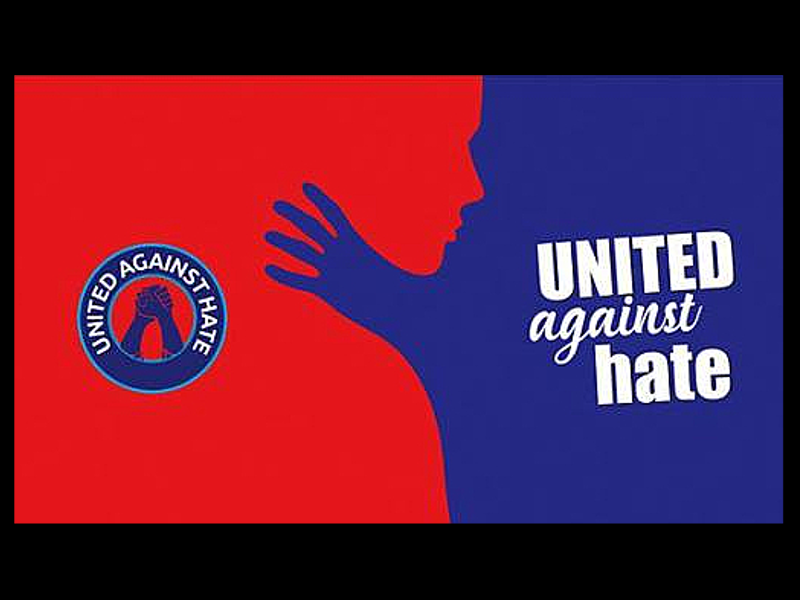United Against Hate is a citizens’ initiative against the rising hate crimes and communal-casteist violence rampant in the country today. This platform was formed in Delhi in August 2017 and since have been running campaigns, meetings and protest demonstrations against various such cases of atrocities. GroundXero sits down for an interview with Nadeem Khan and Bonojyotsna Lahiri, members of the United Against Hate campaign.
groundXero: Let’s start with the how’s and the why’s. How did UAH campaign start? What was the purpose?
United Against Hate (UAH hereafter): We all have been working on these issues so far, but independently. At some point we decided to join all our forces to build an anti-fascist anti-communal campaign, which combines the organisations and individuals who want to work on such issues – a campaign that is open for all. The common minimal agenda started as anti-lynching, anti-hate crimes. But as you keep working you realize that hate crimes, mob lynchings are basically execution model of the fascist ideology. So you generally need to work on an anti-fascist program. That’s what we are doing.
gX: What is the difference of this platform from other such campaigns such as NotInMyName?
UAH: NotInMyName is mostly a cultural resistance. We have a different approach. We hold meetings in neighbourhoods, visit affected areas, work in support of the affected families,and support legal efforts for redress in such instances.
gX: The kind of issues that you have been involved with so far…
 UAH: Of all the lynchings that have happened across north India over the last year, we are in touch with roughly 80% of the victim families. We provide support and organise protests at the relevant offices in New Delhi when such incidents occur. Other than that we are in regular follow-up with the legal cases. We have been visiting the sites of communal violence and bringing out fact-finding reports, such as in Kasganj, or in Bihar. We have conducted public tribunal of the Yogi Government’s encounter killings, and brought out a report. What happens when a lynching happens is that the state immediately builds a counter-narrative. Such as when Pehlu Khan was killed, it was spread that he was carrying beef. After Junaid was killed, it was spread that he had misbehaved with a girl. When Akhlaq was murdered, they said he had beef at his place. Thus whenever such things happen, the yellow journalism media puts all it’s weight behind creating this kind of public opinion whereby the victim is converted into the accused, and the accused into the victim. So our role in such cases remains mainly to bring out the narrative of the actual victim in all this.
UAH: Of all the lynchings that have happened across north India over the last year, we are in touch with roughly 80% of the victim families. We provide support and organise protests at the relevant offices in New Delhi when such incidents occur. Other than that we are in regular follow-up with the legal cases. We have been visiting the sites of communal violence and bringing out fact-finding reports, such as in Kasganj, or in Bihar. We have conducted public tribunal of the Yogi Government’s encounter killings, and brought out a report. What happens when a lynching happens is that the state immediately builds a counter-narrative. Such as when Pehlu Khan was killed, it was spread that he was carrying beef. After Junaid was killed, it was spread that he had misbehaved with a girl. When Akhlaq was murdered, they said he had beef at his place. Thus whenever such things happen, the yellow journalism media puts all it’s weight behind creating this kind of public opinion whereby the victim is converted into the accused, and the accused into the victim. So our role in such cases remains mainly to bring out the narrative of the actual victim in all this.
gX: What about the issues that are in fact buried by the paid media?
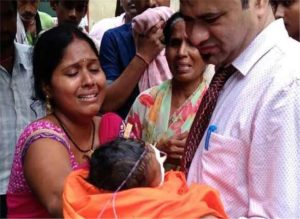
Dr. Kafeel Khan, arrested subsequently by Yogi Government. Source: Internet.
UAH: Take the example of Dr. Kafeel Khan’s issue. No one knew about what was being done to Kafeel. For 8 months the media maintained deafening silence on the fact that this doctor was being persecuted, through incarceration and other means, for trying to save children’s lives in a situation were literally the Government is killing children by cutting off oxygen supply to hospitals. Kafeel had publicly stated that he and his family were being mortally threatened. Of course few days back we saw how his brother was indeed eventually shot by some people. Anyway, so Kafeel’s family was scared. But we assured them that we would seriously follow up if there is a legal battle. We were prepared to file a petition to Supreme Court, in case they rejected his bail application at the High Court. But thankfully he got his bail.
gX: Tell us more about the families of the victims, what do they have to go through in such situations.
UAH: Take for example the situation of Alimuddin’s wife or Salim Ansari’s family. We couldn’t directly organise a press meet with them because the situation was such. What we could do however was to video record their testimonies, live broadcast their side of the story, and push it into the public discourse. Usually the victim families have to go through all kinds of hardship and struggle whenever this kind of things happen. For example, in Latehar 2016 a couple of people, Mazlum Ansari and Chhotu Ansari, were lynched and hung from a tree. Now some money had been collected for supporting Mazlum Ansari’s immediate family. But we got to know that they were swindled off of all that money by a relative. The economic hardships that these families have to go through generally, and in particular when their earning members are killed, is immense.
gX: Is there an economic side to all this cow-related killings, in the context of cattle economy or agrarian economy?
UAH: See the people who have been attacked are mostly dairy farmers. Most of the time they have been carrying milch cows for their dairy business, when they are stopped, branded as cow-smugglers or cow-slaughterers and are attacked and even killed. The dairy farmers, especially muslims in the trade are being severely affected by these attacks. This is an attempt to further marginalize the poor muslim dairy farmers and attack their source of livelihoods. Clearly there is an economic motivation behind all this, and it deserves careful study.
gX: What has been the role of the police in such cases generally?
UAH: The role of police in most places has been pathetic. In the Kasganj fact-finding, Mr. S.R. Darapuri, a retired Inspector General of Police himself was there as part of the fact-finding mission. The local SI kept him waiting for hours. Now if this is how a local police officer treats someone who has been an IG with the police, we can only try to imagine how they respond to a common citizen who is seeking their attention. In the case of Umar Khan’s killing in Alwar, even members of the police force were allegedly involved in the lynch attack.
Father of Umar Khan sharing his pain by describing the incident and how police and politicians tried to misguide them and still trying to save the Criminals and framing the victims family. #UnitedAgainstHate
Posted by United Against Hate on Monday, 20 November 2017
gX: While such attacks on the muslim body are not new in this country, what do you think has changed in recent times, particularly regarding the scale and organised nature of such attacks?
UAH: These things fetch a lot of political returns in today’s times. You get to corner the minority community and push them up against the wall through such tactics, without having to engineer full-blown riots like what used to happen earlier. This is the ‘new mode’ of riots in this country.
gX: What do you have to say about the role of media in such situations?
UAH: You have seen the role of media, Dainik Jagaran for instance, in the case of Asifa. And after the Cobrapost sting, what is even there to talk about the role of media! Today’s paid media doesn’t just shelter the perpetrators, but in many cases it is in fact the media that triggers such attacks. For instance, take the case of Kasganj. The whole battle-cry over this ‘Pakistan Zindabad’ spin narrative was basically started by Aaj Tak’s Rohit Sardana. He started pushing a complete fake news and misinformation campaign.
gX: What about the role of social media like Facebook, WhatsApp, etc.?
UAH: WhatsApp-based rumour campaign played a major role in the Bihar violence, that we conducted a fact-finding into. Same in the Kasganj attacks that happened on 26th January. In creating such a climate of fanaticism around days like 15th August, 26th January, WhatsApp-based social media campaigns play an instrumental role.
gX: Tell us a little more about your modes of organising.
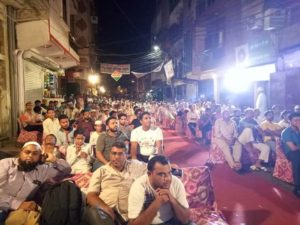 UAH: Protests include various modes such as writing, protests on the streets, hall meetings, street corner meetings, mohalla (neighbourhood) meetings – we have been using all of these modes generally. We are of the opinion that the typical civil society meetings that we are used to seeing, in big halls in Lutyens Delhi, Press Club type spaces, with the same usual set of public speakers – these are not enough to connect with the people at large. As a result of which, what happens is these Dainik Jagaran, Amar Ujala kind of media outlets – the ones that we criticize – end up becoming the only source of information for a large section of people, particularly in the Hindi belt. The only way to break this nexus is therefore to connect with as many people at large as we can, through regular small corner meetings, neighborhood meetings, etc. For instance, on the other side of this Jasola Shaheen Bagh metro line, there is a Gujjar village. We conducted meetings there after Asifa’s rape and murder. This was possibly the first time that this kind of meetings happened in that area.
UAH: Protests include various modes such as writing, protests on the streets, hall meetings, street corner meetings, mohalla (neighbourhood) meetings – we have been using all of these modes generally. We are of the opinion that the typical civil society meetings that we are used to seeing, in big halls in Lutyens Delhi, Press Club type spaces, with the same usual set of public speakers – these are not enough to connect with the people at large. As a result of which, what happens is these Dainik Jagaran, Amar Ujala kind of media outlets – the ones that we criticize – end up becoming the only source of information for a large section of people, particularly in the Hindi belt. The only way to break this nexus is therefore to connect with as many people at large as we can, through regular small corner meetings, neighborhood meetings, etc. For instance, on the other side of this Jasola Shaheen Bagh metro line, there is a Gujjar village. We conducted meetings there after Asifa’s rape and murder. This was possibly the first time that this kind of meetings happened in that area.
The first event that we organised was a bike rally from Delhi to Mewat – the belt where lynchings have regularly been happening – after Junaid was murdered. The first meeting we conducted was at Aaram Park in East Delhi, that was attended by around 700-800 people. Then we conducted a public meeting at Baburpura, again in East Delhi, where there were around 1500-2000 people. We typically conduct these meetings in evenings, after people are back from their work. To put it simply, we want to take public meetings from Jantar Mantar to the mohallas. And we don’t leave right after the meeting. We stay in touch going forward, through WhatsApp groups and other social media platforms. Right now there are around 25 WhatsApp groups that UAH runs.
Hafiz Junaid Brother sharing his pain with all. #UnitedAgainstHate
Posted by United Against Hate on Monday, 20 November 2017
gX: How has been the response in such meetings?
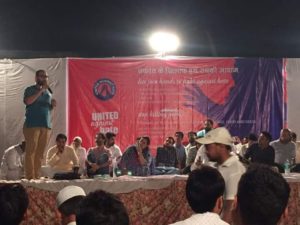
Public meeting at Trilokpuri
UAH: These two meetings for example that we mentioned above, saw a great response from the people. After the Aram Park meeting, we had a meeting at Trilokpuri. Now Trilokpuri is a communally sensitive place, with residents from both religious communities. Trilokpuri had even seen riots in 2014. We have conducted meetings there as well. When we conducted the Yuva Hunkaar Rally, after Jignesh Mevani won the elections, we held a string of meetings for 2-3 days continuously in East Delhi.. We have also been approached by various groups from across the country for organising similar meetings/protests on such issues. For instance, after Asifa’s incident, UAH conducted protests in 30-40 towns across North India.
gX: Tell us a little about the fact-findings you conducted.
UAH: We conducted fact-findings into Kasganj and Bihar. In the case of Kasganj, after we conducted the fact-finding and did a press meet, they stopped every other fact finding team that tried going into Kasganj. Similarly the Bihar fact finding became explosive. Everyone around knew that the swords used in the attacks on Muslims during the Ram Navami processions – as many as around 50,000 swords – had been distributed in an organised way to people in the processions. But no one went on record to talk about it. We did. And then the media picked it up from our report. Not even the opposition parties talked about it before, although everyone obviously knew.
gX: Why would the Opposition not raise this but?
UAH: This kind of hate-crime based politics has become the norm now. Though RJD is the main opposition party in Bihar, none of their senior leaders went there when the attacks happened. Other than sending some of their low-ranking members, all that they did mostly is re-tweet a story that Telegraph did, that was incidentally based on our fact-finding.
Just day before yesterday we got a call from someone in Koderma (Bihar) that Muslims are not being allowed to enter a village there. And it seems this blockade is being led by a local RJD leader who lost the last elections.
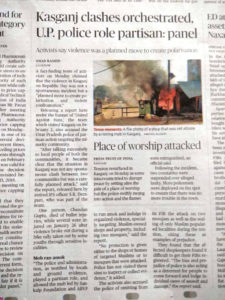
Source: UAH
Basically the point is that everyone is after the soft-Hindutva votes, be it Samajwadi party, be it RJD, or JDU. After Kasganj happened, the Opposition raised question one day in Rajya Sabha and that was all. They didn’t try going and talking to people there, no press conference was held. If you ask about Congress, their leader Salim Sherwani has won many elections from there. Salim’s cousin’s shop was torched in Kasganj this time during the violence, but still he is mum. In Gujarat, in Karnataka we saw Rahul Gandhi showing his janeu (thread), visiting temples etc. So every political party in this country wants the soft-Hindutva votes. Even CPI(M) is not an exception to this.
gX: Ok. Let’s come back to fact-findings…
UAH: Yes, the other such initiative we took was the public hearing on Yogi Government’s encounter spree. This was attended by some of the families of the victims. Not many could come because of the kind of threat that they are under. But some families did come, braving the conditions. Other than these families, some local grassroot activists had come, and Neha Dixit, a journalist who has been covering these encounters – she also came and spoke.
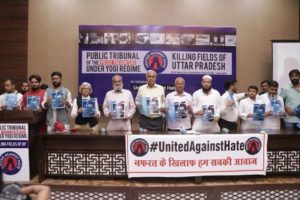
People’s Tribunal on Yogi Government’s encounter killings. New Delhi, 23 March 2018.
Other than this, in the case of Dr. Kafeel Khan, we conducted press conferences and protests on the issue of the children’s deaths in Gorakhpur, and the general state of public health in the country, particularly in UP. Because in a way, these hate crimes etc., are smokescreens to divert people’s attention from real issues such as that of health. So we wanted to bring back attention to such issues.
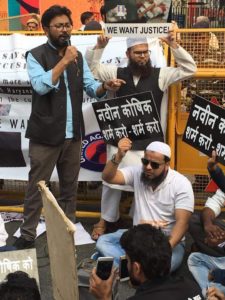
Nadeem Khan speaks at the protest against sabotage by the public prosecutor, at Haryana BHavan, New Delhi.
In the case of Junaid, the public prosecutor Naveen Kaushik, was accused of providing information to the accused, before cross-examination. He was tutoring them. This was a serious charge, and we organised protests against this. He had to finally buckle down and resign, not just because of our protest, but generally due to the public outrage. We held protests after the burning of Afrazul in Rajasthan, on the issue of disappearance of Najeeb from inside JNU, in Lucknow after Bhim Army leader Chandrashekhar Azad Raavan was illegally arrested, in Jaipur, in Deoband, and so on..
gX: How do you raise material resources for your work?
UAH: Mainly through contributions from people themselves. After every meeting we do spot collection. People contribute money according to their capacities.
gX: Coming back to the list of the hate-crimes you were giving just a while back, tell us a bit about efforts that are underway, to document these crimes that are happening across the country…
UAH: One example of documentation that is going on is the DOTO (Documentation Of The Oppressed) database. We are one of the forces behind it, but there are many organisations that are involved. The initial idea was from the Quill Foundation. Here we are trying to document hate-crimes that have been happening since 2014, with community-wise, area-wise categorization, and with details about the legal status of each registered case.
gX: What has been your experience with how this climate of lynching across the country impacts women in particular?
UAH: Lynching kind of violence, particularly hate crimes, have always been historically targeted on women in this country. For instance in Jharkhand, there has been a history of women being lynched under allegations of being a ‘witch’, or if someone doesn’t have a child, and so on. Women have always been one of the most significant sections among the victims of such crimes.
We haven’t gotten around yet to work directly with feminist organisations on these issues however, but all our reports and findings are public documents, and it will be great if the feminist movement could take it up and work in their respective areas or contexts.
gX: Also, what are some of the tenets of this united fight for secularism? For instance, how do you locate the question of dalit-muslim unity in the context of this fight?
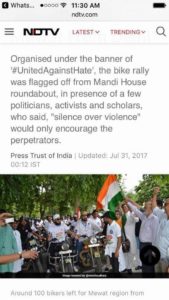 UAH: Through UAH, we mainly want to foreground the question of justice. We believe that secularism, whatever it might mean, can not be sustained purely at a level of ideas unless you are ready to fight for justice. And it is through this central aim of fighting for justice, that the question of dalit-muslim unity becomes naturally unavoidable, because both these communities are the chief targets of State or fascist repression. The normalization of hate crimes and discrimination that we have been seeing in recent times, is communal on the one hand, and deeply casteist on the other. So the resistance to this has to be joint, there is no other go. For example, when we organised protests against the illegal arrest of Bhim Army members, we didn’t do it thinking we have to somehow forge dalit-muslim unity. It was only natural that you protest against such an act, as part of the overall fight for justice.
UAH: Through UAH, we mainly want to foreground the question of justice. We believe that secularism, whatever it might mean, can not be sustained purely at a level of ideas unless you are ready to fight for justice. And it is through this central aim of fighting for justice, that the question of dalit-muslim unity becomes naturally unavoidable, because both these communities are the chief targets of State or fascist repression. The normalization of hate crimes and discrimination that we have been seeing in recent times, is communal on the one hand, and deeply casteist on the other. So the resistance to this has to be joint, there is no other go. For example, when we organised protests against the illegal arrest of Bhim Army members, we didn’t do it thinking we have to somehow forge dalit-muslim unity. It was only natural that you protest against such an act, as part of the overall fight for justice.
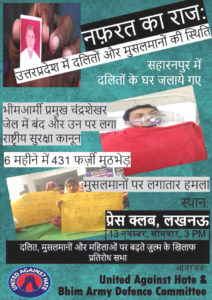 In the Yuva Hunkaar Rally, which called for the release of Bhim Army leader Chandrashekhar Azad Raavan, both dalit groups and muslim groups participated in huge numbers. Now the bigger question of dalit-muslim unity has many facets – such as the kind of discourse that goes on when it comes to electoral politics. We don’t see it as our role to get into such debates or discussions.
In the Yuva Hunkaar Rally, which called for the release of Bhim Army leader Chandrashekhar Azad Raavan, both dalit groups and muslim groups participated in huge numbers. Now the bigger question of dalit-muslim unity has many facets – such as the kind of discourse that goes on when it comes to electoral politics. We don’t see it as our role to get into such debates or discussions.
gX: Since you brought up electoral politics, how does UAH look at elections, does it have any electoral plans in the upcoming 2019 elections?
UAH: The role of civil society is to raise and highlight and target those issues where the political system fails. We wish to do the same. Now UAH is a broad open group, with all kinds of political activists, and it is quite possible that some of them might have their own individual plans of fighting in the elections. But UAH plans to continue the way it is working now, as a mass movement.
gX: What are your immediate future plans?
UAH: What is now going on in Assam – the whole National Register of Citizens (NRC) issue – this is going to render as many as 50 lakh people in Assam stateless, stripping away their citizenship. Our team is going to visit Assam to conduct a fact-finding. We are going to visit all the camps, and bring out a detailed report. Once the report is out, we are going to conduct meetings across various cities in the country, to discuss our findings, and the situation there.
After the Assam fact-finding is over, in July, we plan to go around to those places where hearings for the cases registered (relating to the hate crimes) are to begin. We also have plans to visit those who have been attacked by these lynch groups, but have somehow survived. We want to talk to them and understand how they are doing, what all they are facing. Through all this, we also want to consolidate the mass movement structure of this campaign, so that we can have better coordinated struggles in the months to come.
All photos and videos, unless otherwise specified, are courtesy United Against Hate.

